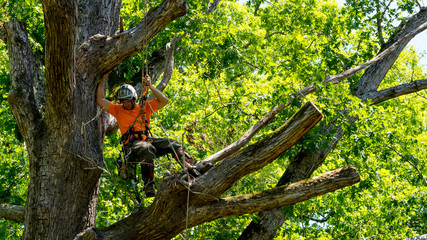Tree Trimming Las Vegas is necessary for tree maintenance, but using the proper techniques is essential. Here are a few tips for performing a tree trim. Make sure that your tools are sharp and disinfected. Avoid using sharp tools on branches with pest infestations or disease, and avoid pruning downward. Instead, prune at an angle to prevent water from pooling and promote callus formation. Once you know how to prune a branch, you’ll be ready for the next step.

First, decide how much of a branch you want to remove. You should avoid removing more than 25 percent of the tree’s canopy. The smaller branches are fine to remove, but the larger ones should only be removed with good reason. It’s important to spread out the work over several years. And remember, the older the tree is, the less energy it has to recover. And if possible, prune the tree in small sections over some time so it won’t look lopsided.
You can find a service for tree trimming in your area, which will charge you by the tree. The cost varies depending on distance and location. You’ll save on travel time by hiring a company already on your property. Additionally, some tree services offer larger discounts for trimming several trees at once. However, keep in mind that unhealthy trees can be dangerous to trim, and it may be necessary to remove the entire tree.
Pruning is an essential part of tree care. It prevents overgrowth and gives your tree a more streamlined appearance. Plus, pruning removes dead or diseased branches and protects them from infection. Whether you’re looking to prune your tree or maintain the appearance of your landscaping, tree trimming is essential. Make sure you schedule your appointment with a tree service professional to prevent any problems. And don’t forget to remember that the cost is worth the quality of service.
Some common techniques used in tree trimming are crown reduction, a procedure for removing foliage from the top of a mature tree. But these techniques have their disadvantages. Topping cuts reduce the height of a tree’s canopy while damaging the structure above it. Crown reduction should never exceed one-third of the tree’s crown. Another common technique is crown lifting, which helps remove low branches that could obstruct pathways or brush against buildings.
Pruning your tree can be a big project. Large shade trees should be left to qualified arborists with the proper training and equipment to prune them safely. However, you can learn the basic principles of tree trimming by pruning ornamental or fruit trees. Both types of trees can be pruned with simple tools. And remember to be careful to use gloves. A tree trimming expert can help you get the job done right the first time.
Pruning is another popular method. Removing dead or dying limbs from the tree can shape the tree for more beauty and a more pleasing look. Regular pruning will also minimize the chances of falling branches, reducing the habitat for snakes and pests. You can also perform thinning or topping pruning to remove a single branch from the tree. Topping is a technique that removes components down to the trunk, which is often used to train young trees.
Pruning young trees is another essential part of tree care. To create a sturdy structure, you should avoid removing vigorous branches. Vigorous branches can change the growth habit of other branches, leaving a tree with an uneven form. Proper trimming will keep your tree’s natural shape while stimulating sparse areas and limiting unwanted growth. So call in an arborist today! A tree’s structure will thank you.
Pruning is important for overall tree health. Pruning helps to stimulate new growth, improve air circulation, and increase sunlight penetration. Proper pruning promotes vibrant color and ensures a tidy tree. Besides that, proper pruning will eliminate the possibility of tree disease, pest infestation, and rot. By scheduling your tree trimming, you’ll be able to enjoy a beautiful and healthy tree for many years to come.
Tree trimming is important for two main reasons: aesthetics and safety. You can hire a professional arborist if you want a beautiful, healthy tree. They’ll know exactly how to do it. Plus, they’ll know the right tools to use. For best results, consult with an arborist before you perform any pruning or trimming yourself. And remember, there are times when it’s necessary to cut back the branches to avoid dangerous situations.
